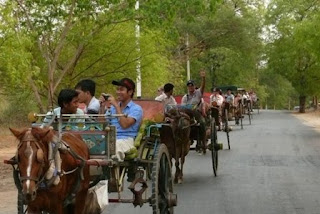Myanmar’s countryside is similar to that in my country, Cambodia. You can see many similar activities, such as people growing palm trees and gaining benefit from these trees, people using the trucks with plenty of passengers sitting on the roof. These reminded me of what I had seen in Cambodia.
- Seang Sopheak
Something special that I found in Bagan city was growing palm trees. Because this area is dry, it is not suitable for growing others crops, so the Myanmar government organized a system of growing palm trees to assist their villagers’ livelihood. In this area they grow a lot of palm trees in large areas. Around the road villagers there were many shops to sell their products from palm trees such as sugar, alcohol, etc. These products can bring a lot income to the people in this area.
- Khamla Soubandith




We had a chance to visit the Nat house in Mt. Popa where situated 37 Great Nats. A Nat is the spirit of a person who died unnaturally. People worship different Nats for different purposes – for education, health, wealth, etc. Later, I also started to notice the Nat shrines on the trees in different villages or places that we visited. This belief interests me a lot because there is no such belief in Thailand.
- Nat
Besides Buddhism, the Union of Myanmar also believes in “Nat” (spirits) as well. You can see The Nat clearly in the POPA Mountain. Many people in Myanmar also believe in Nat together with Buddhism. I was surprised that the Nat images in the Union of Myanmar were very beautiful. They are opposite to the ugly images of ghosts in other countries.
- Khamla
“You see and you believe.” That’s what I heard before departing for Myanmar. It’s true that many things surprised me during the trip. What impressed me the most was a huge range of temples in Bagan and the semi-desert climate there. This pre-eminent ancient religious city can be compared to Angkor in Cambodia for their expanse of sacred geography and the number and size of their individual temples. Interestingly, it was unlike Angkor in that when sprawling across a vast dusty plain, the ruins of Bagan were unhidden. There were no trees to obstruct the view, and I was able to gaze over forty square miles of countryside, upon literally thousands of temples.
- Moon
Bagan became a powerful kingdom in the 11th century, after the Ancient Khmer kingdom. When came to the reign of King Anawratha, Bagan was a major city which had important objects such as the Tripitaka scripture which later changed Bagan into a religious center. When I arrived in Bagan, I was stunned by many various styles of pagodas.
- Aon
 "If you point your finger in any direction, you will hit at least one or two pagodas," says Dr.Sunait. With fervent devotion, these (Bagan) people constructed more than 3,000 temples, stupas and monasteries, and what remains is a magnificent, impossible feat: a collection of religious monuments literally strewn across the 42-sq-km landscape, some no bigger than a pile of bricks, others rivaling the grandest accomplishments of the ancient world.
"If you point your finger in any direction, you will hit at least one or two pagodas," says Dr.Sunait. With fervent devotion, these (Bagan) people constructed more than 3,000 temples, stupas and monasteries, and what remains is a magnificent, impossible feat: a collection of religious monuments literally strewn across the 42-sq-km landscape, some no bigger than a pile of bricks, others rivaling the grandest accomplishments of the ancient world. More than 2,000 temples and stupas have already been rebuilt or repaired, although the process has been widely criticized by archeologists and historians. "If you want to know what the temples looked like before reconstruction, you should look at Shwezigon," says Dr.Sunait. The magnificent gold and white pagoda, famous because of the Buddha forehead relics believed to be stored inside, was largely untouched by the quake.
More than 2,000 temples and stupas have already been rebuilt or repaired, although the process has been widely criticized by archeologists and historians. "If you want to know what the temples looked like before reconstruction, you should look at Shwezigon," says Dr.Sunait. The magnificent gold and white pagoda, famous because of the Buddha forehead relics believed to be stored inside, was largely untouched by the quake.- William











No comments:
Post a Comment